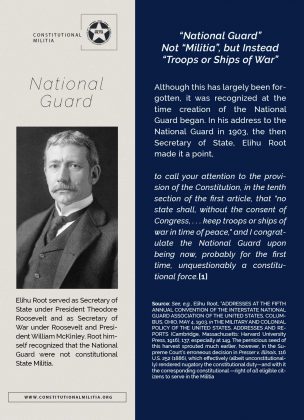Last Updated on July 11, 2022 by Constitutional Militia
National Guard: Not a Constitutional State Militia
The National Guard is neither “[a] well regulated Militia”, as the Second Amendment uses that term; nor one or part of “the Militia of the several States”, as the original Constitution uses that term; nor any form of “militia” whatsoever.
The National Guard is not a “Militia” nor any part of “the Militia of the several States”
All too often today, one hears that the National Guard is the modern “militia”; or even that the very concept of the “militia” is entirely outdated. Self, evidently, though, if the National Guard is the is the modern “militia”, then the “militia” cannot be an outdated concept. Regardless, properly understood in a legal and historical context, the National Guard is incapable and insufficient to perform all the functions required of “[a] well regulated Militia”.[1]
The propaganda the National Guard puts forth tries to characterize it as some sort of “militia”, even claiming that its birth date should be taken as the day the Massachusetts Militia was first mustered in the mid 1600s. This is exceptionally dilute hogwash. At the earliest the National Guard (along with its naval component, the so-called Naval Militia) began only in 1903; and the National Guard started to assume most of its present form only in several statutes enacted from 1908 to 1916.[2]
When Congress clothed the National Guard and the Naval Militia with the deceptive cloak of “the organized militia”, rather than candidly identifying them as the “‘Troops or Ships of War” which States may “keep * * * in time of Peace” “with[ ] the consent of Congress”,[3] this vital distinction was improperly abandoned.[4] Upon revitalization of the Militia it should be reinstated.
The National Guard is not a “militia”. The legislated structure of the National Guard is the exact opposite. The National Guard is a voluntary structure that is an adjunct of the Army and the Navy, which can and has been called up for reasons other than the 3 constitutional reasons required for “the Militia of the several States”. Constitutional Militia are never subject to the command of the officers of the regular Armed Forces, but only to the Militia officers appointed by the States, a direct “check and balance” against a “standing army”.
When the Militia are on active duty within the several States, for the States’ own purposes, the States enjoy the exclusive authority to prescribe and enforce rules for their governance.[5]
































